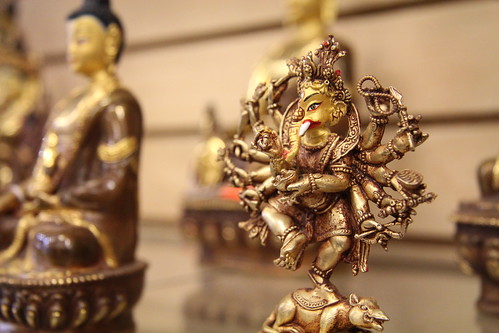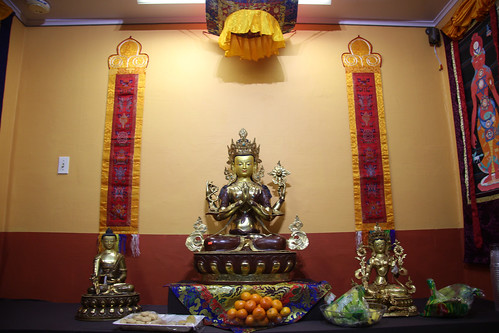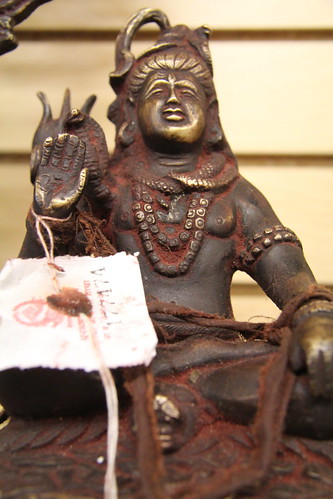A new store has brought the Far East to Ballard.
Himalayan Treasures (1708 NW Market Street) opened its doors last week and owner, Sushil Mulepati, invited the Ballard News-Tribune to view the intricate and exotic items inside. The store celebrates the craftsmanship of Nepal, Tibet, Buddhism and Hinduism.
Mulepati is from Nepal and lived there most of his life until a five-year stint in Hawaii. He recently moved to Seattle to be with his family. Mulepati has been collecting the artifacts for most of his life and maintains close relationships with craftspeople in Nepal. He sources many of his items from non-profit organizations and artisans. Mulepati also owns a tour company that leads groups in Nepal and Tibet.

Sushil Mulepati, owner of Himalayan Treasures, is from Nepal.
Walking into the store is like entering a temple adorned by mosaics of dazzling color and wonder. Statures of a smiling Buddha resting in lotus position are the first things seen. Singing bowls, silk scarves, Buddhist Thangka paintings and woven rugs are just a few fine treasures on display at the shop.
There’s a sharp contrast in the shop after coming off the busy street. It’s calm inside. The sweet scent of traditional herbal incense fills the room. Mulepati is also very relaxed. He speaks gently about the things in the store.
Overhead is a large, intricate painting that depicts the life of Buddha.
“These kinds of paintings of this size take a long time --- almost a year --- and usually the high lamas paint this type of good quality painting.”
Traditional beads hang in rows, covering a portion of the store. Mulepati has many different types of beads but pointed out the Bodi Tree and Rudraksha (mala) beads. The Rudraksha is a seed from a tree that only grows in the Himalayas.
“It’s believed to be grown from Shiva’s tears and brings good luck. Lots of people wear that.”
Mulepati said that many people come to Nepal to buy the bead. He said that recently the beads have become popular in China and that the demand for it has gone up.
“The price has gone up for the beads because they buy the whole tree,” he said and laughed.

Intricate Ganesha statue.
Next, Mulepati points out the hand-pounded singing om bowls at the shop. Each bowl has a dull metallic aspect. Hammer marks on the bowl reveal how each one is hand molded and/or pounded. He said the bowls are made to heal the chakras with a resounding din made of multiple tones. Mulepati circled the edge of the bowl with a mallet and a warm, deep tone filled the room. Placing a hand next to the bowl, one can feel the heavy vibration moving from the bowl.
Some bowls have designs on them that symbolize protection and peace.
“The healers use the bigger bowls like this.”
Mulepati picks up the largest bowl and gave it a gentle tap.
“They use it for the vibrations and the good sound. They choose the ones that last longer. … If you close your eyes, you feel relaxed and can feel the effects.“
We close our eyes and listen to the tone for a few seconds. The bowls really do sing. We slowly open our eyes and laugh.
“You see? You feel the effects.”
Each bowl is hand molded and hammered from seven different metals, including gold, silver, copper, tin, zinc, lead and mercury. Mulepati said the metals represent the seven chakras. Some bowls produce one distinct note, but Mulepati believes the bowls produce all notes and excite all the chakras.
“They align the chakras, balance the chakras, and it calms you down. You relax when you hear it.”

Meditation room.
That’s just the feel Mulepati had in mind for his store. He even constructed a meditation room for customers.
“I just wanted to offer a place for customers to relax and meditate if they want to.”
Soft meditating pillows are in rows on a large woven rug. At the head of the room is a large golden stature of Buddha. Ganesha and Shiva are there, too.
By far, the most alluring items in the store are the statures. Mulepati showed one section of the store with all figures made from copper.
“These are all made out of copper inside. Copper is easier to carve than brass. Brass can break. They are all hand rolled and then they clean it, carve it and buff it.”
After the statures are carved they oxidize the metal then add gold. Next is the paint. 24 carrot gold powder is meticulously added to make the intricate nuances of each face.
One statue, Shiva (in Hinduism Shiva is believed to be the creator and destroyer, revealer and concealer) bears an open hand.

A statue of Shiva with an open hand.
“Why does Shiva do that? What does it mean?” I ask.
“It’s a blessing. It has lots of meaning…I know a little, but I’m learning all the time.”